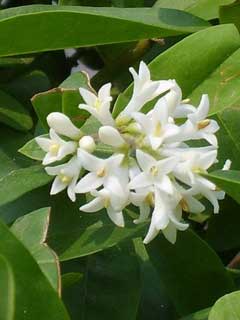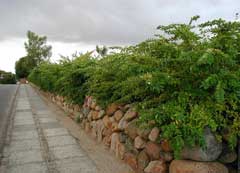 |
|
http://commons.wikimedia.org/wiki/User:Dalgial |
 |
| http://commons.wikimedia.org/wiki/User:Sten |
Translate this page:
Summary
Bloom Color: White. Main Bloom Time: Early summer, Early spring, Late summer, Late spring, Mid summer, Mid spring. Form: Vase.
Physical Characteristics

 Ligustrum obtusifolium is an evergreen Shrub growing to 3 m (9ft 10in) at a medium rate.
Ligustrum obtusifolium is an evergreen Shrub growing to 3 m (9ft 10in) at a medium rate.
See above for USDA hardiness. It is hardy to UK zone 3. It is in leaf all year, in flower in July, and the seeds ripen in October. The species is hermaphrodite (has both male and female organs) and is pollinated by Insects.
Suitable for: light (sandy), medium (loamy) and heavy (clay) soils and can grow in heavy clay soil. Suitable pH: mildly acid, neutral and basic (mildly alkaline) soils. It can grow in semi-shade (light woodland) or no shade. It prefers moist soil.
UK Hardiness Map
US Hardiness Map
Synonyms
L. ibota. Sieb.
Plant Habitats
Woodland Garden Sunny Edge; Dappled Shade; Ground Cover;
Edible Uses
Edible Parts:
Edible Uses: Coffee Tea
The roasted seed is a coffee substitute[61, 177]. Leaves are a tea substitute[177].
References More on Edible Uses
Medicinal Uses
Plants For A Future can not take any responsibility for any adverse effects from the use of plants. Always seek advice from a professional before using a plant medicinally.
None known
References More on Medicinal Uses
The Bookshop: Edible Plant Books
Our Latest books on Perennial Plants For Food Forests and Permaculture Gardens in paperback or digital formats.

Edible Tropical Plants
Food Forest Plants for Hotter Conditions: 250+ Plants For Tropical Food Forests & Permaculture Gardens.
More

Edible Temperate Plants
Plants for Your Food Forest: 500 Plants for Temperate Food Forests & Permaculture Gardens.
More

More Books
PFAF have eight books available in paperback and digital formats. Browse the shop for more information.
Shop Now
Other Uses
Wax
A commercial insect wax is produced on the branches as a result of eggs being laid by insects[11]. Another report says that the wax is produced by the plant due to the stimulation of the feeding insects[61]. Yet another report says that the wax is produced by the insects[178]. It is used for candles and as a polish for earthenware pots, book edges etc[178]. The sub-species L. obtusifolium regelianum and its cultivar 'Dart's Perfection' make a good carpeting ground cover about 1.2 metres tall. They should be spaced about 2.5 metres apart each way[208].
Special Uses
Ground cover
References More on Other Uses
Cultivation details
Landscape Uses:Foundation, Hedge, Screen, Superior hedge. A very tolerant and easily grown plant, it succeeds in any soil that is not impoverished or water-logged[11, 182]. Grows well in heavy clay soils. A very ornamental plant[1]. Polymorphic[58]. Prefers hotter summers than are normally experienced in Britain[11]. Closely related to L. ovalifolium[200]. This species is notably susceptible to honey fungus[200]. Special Features:Not North American native, Invasive, Attractive flowers or blooms.
References Carbon Farming Information and Carbon Sequestration Information
Temperature Converter
Type a value in the Celsius field to convert the value to Fahrenheit:
Fahrenheit:
The PFAF Bookshop
Plants For A Future have a number of books available in paperback and digital form. Book titles include Edible Plants, Edible Perennials, Edible Trees,Edible Shrubs, Woodland Gardening, and Temperate Food Forest Plants. Our new book is Food Forest Plants For Hotter Conditions (Tropical and Sub-Tropical).
Shop Now
Plant Propagation
The seed does not require any pre-treatment and can be sown in the spring in a cold frame[113]. When they are large enough to handle, prick the seedlings out into individual pots and grow them on in the greenhouse for at least their first winter. Plant them out into their permanent positions in late spring or early summer, after the last expected frosts. Cuttings of half-ripe wood, 5 - 10cm with a heel, July/August in a frame. Very easy[78]. Cuttings of mature wood, 20 - 30cm in a sheltered outdoor bed in November/December. High percentage[78].
Other Names
If available other names are mentioned here
Native Range
TEMPERATE ASIA: China (Heilongjiang Sheng, Jiangsu Sheng, Liaoning Sheng, Shandong Sheng, Zhejiang Sheng), Korea, Japan (Hokkaidô (south), Honshu, Kyushu, Shikoku)
Weed Potential
Right plant wrong place. We are currently updating this section.
Please note that a plant may be invasive in one area but may not in your area so it's worth checking.
Conservation Status
IUCN Red List of Threatened Plants Status :

| Related Plants
|
| Latin Name | Common Name | Habit | Height | Hardiness | Growth | Soil | Shade | Moisture | Edible | Medicinal | Other |
| Ligustrum delavayanum | | Shrub | 3.0 |
6-9
| | LMH | FSN | M | 0 | 0 | 3 |
| Ligustrum indicum | | Shrub | 3.0 |
-
| | LMH | SN | M | 1 | 0 | |
| Ligustrum japonicum | Japanese Privet, Japanese Ligustrum, Waxleaf Ligustrum, Texas Privet, Waxleaf Privet | Shrub | 5.0 |
7-10
| M | LMH | SN | M | 1 | 1 | 3 |
| Ligustrum lucidum | Chinese Privet, Glossy privet, White Wax Tree, Tree Ligustrum | Shrub | 10.0 |
8-11
| M | LMH | FSN | M | 1 | 3 | 3 |
| Ligustrum ovalifolium | Privet, California privet | Shrub | 4.0 |
4-8
| M | LMH | FSN | DM | 0 | 0 | 3 |
| Ligustrum sinense | Chinese Privet | Shrub | 3.0 |
7-10
| M | LMH | SN | M | 0 | 1 | 3 |
| Ligustrum vulgare | Privet, European privet , Common Privet | Shrub | 3.0 |
4-7
| M | LMH | SN | DM | 0 | 1 | 3 |
|
Growth: S = slow M = medium F = fast. Soil: L = light (sandy) M = medium H = heavy (clay). pH: A = acid N = neutral B = basic (alkaline). Shade: F = full shade S = semi-shade N = no shade. Moisture: D = dry M = Moist We = wet Wa = water.
Now available:
Food Forest Plants for Mediterranean Conditions
350+ Perennial Plants For Mediterranean and Drier Food Forests and Permaculture Gardens.
[Paperback and eBook]
This is the third in Plants For A Future's series of plant guides for food forests tailored to
specific climate zones. Following volumes on temperate and tropical ecosystems, this book focuses
on species suited to Mediterranean conditions—regions with hot, dry summers and cool, wet winters,
often facing the added challenge of climate change.
Read More
Expert comment
Author
Siebold.&Zucc.
Botanical References
1158200
Links / References
For a list of references used on this page please go here
Readers comment
| Add a comment |
|
If you have important information about this plant that may help other users please add a comment or link below. Only comments or links that are felt to be directly relevant to a plant will be included. If you think a comment/link or information contained on this page is inaccurate or misleading we would welcome your feedback at [email protected]. If you have questions about a plant please use the Forum on this website as we do not have the resources to answer questions ourselves.
* Please note: the comments by website users are not necessarily those held by PFAF and may give misleading or inaccurate information.
To leave a comment please Register or login here All comments need to be approved so will not appear immediately.
|
Subject : Ligustrum obtusifolium
|
|
|
|